Soviet rocketry
Soviet rocketry spanned the entire history of the Soviet Union (1922–1991). Rocket scientists and engineers contributed to the development of rocket and jet engine propulsion systems, which were first used for artillery and later for fighter aircraft, bombers, ballistic missiles, and space exploration. Progress was greatly augmented by the reverse engineering of German technology captured by westward-moving troops during the final days of World War II and the immediate period following.
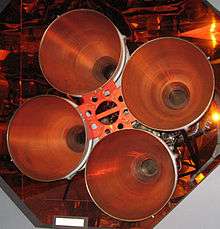
Liquid Fuel: The early contribution

Traditionally, the Russian military had used only solid fuel in rockets (generally black powder). Russian involvement in rocketry began in 1903 when Konstantin Tsiolkovsky published a paper on liquid-propelled rockets (LPREs).[1] Though the idea of rockets stems from the 1600s, Tsiolkovsky's efforts made significant advances in the use of liquid fuel. His work challenged traditional thought and sparked a revolution in science which embraced new ideas in rocket technology.[1]

One of the early leaders in Russian rocket engine development was Friedrich Zander, a German-born spaceflight enthusiast. Zander was the head of a group of rocket researchers called GIRD, the Russian acronym for "Group for Research of Reactive Propulsion," which was created in 1931. Zander, who idolized Tsiolkovsky and the German rocket scientist Hermann Oberth, oversaw the development of Russia's first liquid fueled rocket, the GIRD 10. The rocket was launched successfully in 1933, and it reached an altitude of 1300 feet (400 m), but Zander died before the test took place.[2]
Two research groups played exceptionally important roles in the early development of Soviet Cold War-era jet propulsion: The Leningrad Gas Dynamics Laboratory (GDL), and the Group for Research of Reactive Propulsion (GIRD). Due to their similar objectives and parallel existence, there was some overlap between GDL and GIRD, and the two organizations were eventually merged. Generally speaking, however, while the GDL focused primarily on the development of rocket engines, GIRD was involved with the engineering design, construction, and testing of the craft that would be powered using the engines that the GDL developed.[3]
The GDL was formed in 1928, initially focusing primarily on the development of solid-fuel rockets for military use, such as anti-aircraft and anti-tank weapons, though it branched out into liquid-fueled rocket engines in May 1929. These rockets were developed to be used as engines for aircraft instead of for conventional artillery. It was primarily through the work of the GDL that the OR and ORM series of rocket engines were developed, which would become the backbone of early Russian jet development.[4]
GIRD began as the Jet Engine Section of a larger civil defense organization known as the Society for the Promotion of Defense and Aerochemical Development; GIRD's role was to deliver practical jet engine technology to be employed in aerial military applications. Although branches of GIRD were established in major cities all throughout the Soviet Union, the two most active branches were those in Moscow (MosGIRD, formed in January 1931) and in Leningrad (LenGIRD, formed in November 1931).[5] MosGIRD worked on the development of space research, liquid-propellant rockets, rocket design as it pertained to aircraft, and the construction of a supersonic wind tunnel (used for the aerodynamic testing of the aircraft that they developed), whereas LenGIRD developed solid-fuel rockets used for photographing the upper atmosphere, carrying flares, and atmospheric sounding.[6]
Early pioneers in the field began to postulate that liquid fuels were more powerful than solid fuels.[7] Some of the early fuels used by these scientists were oxygen, alcohol, methane, hydrogen, or combinations of them.[7] A bitter rivalry developed between the researchers of these institutes.[1]
In order to obtain maximum military benefits, the Red Army's chief-of-staff Marshal Mikhail Tukhacheskii merged GIRD with the GDL to study both fuel types. The new group was given the designation RNII.[1] Before merging, the GDL had conducted liquid fuel tests and used nitric acid, while the GIRD had been using liquid oxygen.[1] A brilliant, though often confrontational Sergei Korolev, headed the GIRD when it merged into RNII, and he was originally RNII's deputy director. Korolev's boss was a hard-nosed man from the GDL by the name of Kleimenov. Bitter in-fighting slowed the pace and quality of the research at RNII, but despite internal dissention, Korolev began to produce designs of missiles with liquid fueled engines. By 1932, RNII was using liquid oxygen with kerosene as a coolant as well as nitric acid and a hydrocarbon.[7] By 1933, the Soviets had successfully developed the GIRD 09. The engine was tested on a glider, which reached a propelled altitude of 1300 feet (400 m) before its thrust chamber failed.[7]
Applications in early aircraft
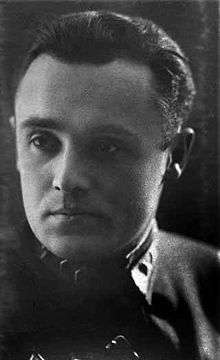
As a young adult, Sergei Korolev (1907–1966) had always been fascinated by aviation. At college, his fascination towards rocketry and space travel grew. He became one of the most important rocket engineers of Soviet aircraft technology, and became "Chief Designer" of the Soviet space program.[8] Sergei Korolev was a vitally important member of GIRD, and later became the head of the Soviet space program. Korolev would play a crucial role in both the launch of Sputnik in 1957, and the mission which put Yuri Gagarin in space in 1961.
In the early stages of Soviet rocketry science, Korolev, who initiated the program in Moscow, called the Group for the Study of Reactive Motion, abbreviated as GIRD in Russian. As a renowned aeronautical engineer and the director of GIRD, he and his colleagues were enthusiastic supporters of Russia's race to space, and their focus was aimed at using liquid propellant to push their rockets into the atmosphere.[1]
In 1931, Korolev had come to Zander with a conceptual design for a rocket-powered aircraft called the RP-1.[2] This craft was essentially a glider, powered with one of GDL's rocket motors, the OR-2. The OR-2 was a rocket engine powered with gasoline and liquid oxygen, and produced a thrust of 500 newtons (110 lbf). In May 1932, about a year before Zander died, Korolev became the director of GIRD. At this point, he continued developing his design for the RP-1, an updated version called the RP-2, and another craft that he called the RP-218. The plan for the RP-218 called for a two-seat rocket powered plane, complete with a pressurized cabin, a retractable undercarriage, and equipment for high altitude research. The design was never realized, though, because at the time, there was not a rocket powerful enough and light enough to make the RP-218 practical.[2]
In September 1933, GIRD was combined with the Gas Dynamics Laboratory, and the conglomerate was named the RN II Rocket Scientific Research Institution. When the two institutes combined, they brought together two of the most exceptional and successful engineers in the history of Soviet rocketry. Korolev teamed up with propulsion engineer Valentin Glushko, and together they excelled in the rocket industry, pushing the Soviet Union ahead of the United States in the space race. Instead of pursuing the RP-218, in 1935, Korolev and RN II began developing the SK-9, a simple wooden two-seat glider which was to be used for testing rocket engines.[9] The rear seat was replaced with tanks holding kerosene and nitric acid, and the OR-2 rocket motor was installed in the fuselage. The resulting craft was referred to as the RP-318. The RP-318 was tested numerous times with the engine installed, and was deemed ready for test flights in April 1938, but the plane's development halted when Joseph Stalin performed a purge of RN II, executing the director and chief engineer, and imprisoning Korolev to the Kolyma gold mines for 10 years.[10] Despite all of his achievements, Korolev's identity actually remained a Soviet secret up until his death in 1966.[8] Glushko, in parallel, suffered a similar fate and sentenced to eight years imprisonment but working on various aircraft projects with other arrested scientists.
World War II
The Soviets began to redesign the thrust chambers of their rocket engines, as well as investigate better ignition systems. These research endeavors were receiving more attention and funding as Europe began its escalation into the chaos of World War II. The Soviet rocket program had developed engines with two-stage ignition and variable thrust nearly two years before Germany rolled out their Me 163.[7] However, the Soviet engine was only on gliders for testing, and was not available for full-powered flight. The engine's thrust was too low, and pressure build-up caused systemic failures.
Toward the end of 1938, work resumed on the RP-318 at N II-3, which was the new title for the Rocket Scientific Research Institution. The aircraft was repaired and modified, with the addition of a new, more powerful engine to replace the OR-2. The new engine (the ORM-65) had been originally designed for a use in a single-launch cruise missile, but was adapted so that it could be employed in a multi-use aircraft.[11] For comparison to the OR-2, the new ORM-65 could produce a variable thrust between 700 and 1,400 newtons (160 and 310 lbf). After extensive testing, on February 28, 1940, the new RP-318-1 was successfully tested in a full-powered flight; the craft attained a speed of 90 mph (140 km/h), reached an altitude of 1.8 miles (2.9 km), in 110 seconds of operation, and was landed safely when the fuel was exhausted. Although this was a momentous occasion in Russian jet development, further plans to enhance this aircraft were shelved, and when the German Army neared Moscow in August 1941, the RP-318-1 was burned to keep it away from the Germans.[12]
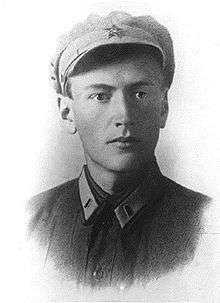
The German invasion of Russia in the summer of 1941 led to an acute sense of urgency for the Soviets to develop practical rocket-powered aircraft. The Russian conventional air force was dominated by the Luftwaffe, with scores of their planes being shot down by individual German fighters.[2] The Russians needed a superior weapon to counter the German air forces, and they looked to rocket-powered interceptor craft as the solution to their dilemma. In spring of 1941, Andrei Kostikov (the new director of N II-3, previously RN II) and Mikhail Tikhonravov began designing a new rocket-powered interceptor, the Kostikov 302.
The Kostikov 302 became the first Russian rocket plane that would have many features shared with modern fighter aircraft. It was built out of wood, with some aluminum, but it included a pressurized cockpit and retractable landing gear. Another key aspect of the Kostikov 302 was that it was equipped with hydraulic actuators, which allowed the pilot to fly the aircraft with more ease. These actuators, in effect the equivalent of power steering in a car, greatly reduced amount of force the pilots had to apply to control the plane. Because of the ongoing war with Germany, Russian officials strove to make the Kostikov aircraft a functional military asset as quickly as possible. This entailed outfitting it with armored glass, armored plates, several 20 mm cannons, and the option of a payload of either rockets or bombs under the wings. Although it had limited range, this aircraft became a serviceable tool for the purpose of brief forays, such as intercepting enemy aircraft. However, by 1944, the 302 was unable to reach Kostikov's performance requirements, in part because the engine technology was not keeping pace with the aircraft development.[13]
The research teams made an important breakthrough in 1942: finally producing a tested and combat-ready rocket engine, the D-7-A-1100. This utilized a kerosene liquid fuel with a nitric acid oxidizer. However, the Nazi invasion had the Soviet high command centered on other matters, and the engine was never produced for use.[7]
German impact
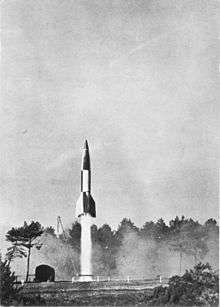
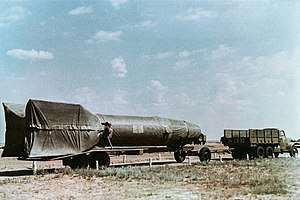
By 1944 Nazi Germany was crumbling underneath a two front war. Both American and Soviet forces were in a race for German rocket facilities. Already in August 1944, the Soviet army conquered the demolished German test site in Dębice, Poland, and found debris of dismantled V-2 missiles and remnants of launch pads which allowed to collect basic technical data of the German rocket program. The Soviet army occupied Peenemünde on May 5, 1945, where all German activities had been shut down in early February 1945 and transferred to the area around Nordhausen with the Mittelwerk for mass fabrication of V-2s. Realizing the importance of their capture, the Soviets immediately began salvage and repair of the test facilities in Peenemünde. As part of the Peenemünde occupation, the Soviets obtained the V-2 rocket platform, some conceptual studies of the A-9/A-10 ocean range rockets, the Rheinbote short-range surface-surface missile, and the R4M air-to-air rocket, called Orkan by the Germans. These represent a few of the notable platforms, captured mostly intact and operational.
The Soviets began an equivalent operation to Operation Paperclip in order to catch German scientists. They missed Wernher von Braun's research group which voluntarily surrenderd to the US Army on May 2, 1945, and most of the Peenemünde scientists who preferred working on the British or American side. In addition, the US Army was able to capture and remove more than 100 completed V2-s and assembled components, together with all relevant documents for the design and manufacturing, from the Mittelwerk before they handed it over to the Soviet army by July 1945, as agreed earlier during the Yalta Conference. As the only experienced rocket scientist the Soviets convinced Helmut Gröttrup[14], the head of the group for developing the V-2 control systems from 1941, to set up the Institut Gröttrup in Bleicherode, and also hired more German scientists to build the Institut Rabe for reconstructing the V-2 and other German weapons.[15] In early 1946, Gröttrup was appointed general director of the Institut Nordhausen which swelled to 5500 personnel for restoring the V-2 documentation and full production of V-2 components until October 1946.[16] After the completion of this task, a selected group of about 160 scientists was forcibly moved to the USSR to remain on Gorodomlya island as part of the Operation Osoaviakhim on October 22, 1946, among more than 2000 other German experts to other locations and other industries for ensuring and completing the knowledge transfer of German technology.[17][18] Korolev was appointed chief engineer for the Soviet experts delegated to Institut Nordhausen, and Glushko was in charge of the group reestablishing the V-2 engine and its testing.
Another major factor in the development of modern Russian aircraft was technology obtained from the Germans after the end of World War II. Since most of the Axis powers were in no condition to repay the billions of dollars that they supposedly owed, the Soviets deployed "trophy brigades", whose task it was to confiscate all equipment, materials, and technology that would be of scientific use to the USSR.[19] Siddiqi points out that the Soviets obtained models of multiple jet fighters, jet engines, and a wealth of technical information concerning equipment related to aviation. By the summer of 1945, the Soviet Union had control of 600 German aviation plants, which constituted more than 50% of all of Germany's aerospace industry. In fact, the Soviet Commissariat of Aviation Industry (NKAP) sent Russian aviation engineers to Germany in order to study in-depth details of German aircraft design: wing design, rocket propulsion, and electronic systems were of particular interest.[19] German expertise about reactive propulsion played a considerable role in the progression of Soviet development of both jet aircraft and rocket-powered spacecraft. Major General Nikolai Petrov, who headed a commission sent by the NKAP to examine German research facilities, informed the trophy brigades in Soviet occupied Germany that their task involved:
... the removal, safekeeping and shipment to Moscow of all German experimental aircraft and engines of all types; aviation equipment, components and all materials associated with their design and production; scientific research materials; laboratory installations; wind tunnels; instrumentation; libraries; and scientific archives. The Commission must work on the scene immediately after Soviet troops capture appropriate locations, scientific centers and industrial regions of Germany.[19]
By October 1948, the Soviet Union had built a replica of the V-2, called R-1, and successfully launched it at Kapustin Yar. From 1947 until the end of 1950, the German team elaborated concepts and improvements for extended payload and range under the projects G-1, G-2 and G-4.[20] The German team had to remain on Gorodomlya island until as late as 1952 and 1953. In parallel, Soviet work was focused on larger missiles, the R-2 and R-5 under Dmitry Ustinov and Sergei Korolev, based on further developing the V-2 technology with using ideas of the German concept studies.[21] Details of Soviet achievements were unknown to the German team and completely underestimated by Western intelligence until, in November 1957, the Sputnik 1 satellite was successfully launched to orbit by the Sputnik rocket based on R-7, the world's first intercontinental ballistic missile.[22]
First Soviet ballistic missile using storable propellants was developed from the German Wasserfall surface-to air missile (SAM) by Korolev's OKB. It was called the R-11 missile.[23] The R-11 was operational by 1955, had a range of 270 kilometers, and had an engine with a thrust of 8300 kgf. This system became the basis for Submarine Launched Ballistic Missiles (SLBM). However, this application required a change of fuel from the land based fuel of Nitric acid with kerosene to the actual V-2 fuel using a graphite gas jet.[24]:735–740
Advances in military systems
Over the course of the Cold War, the Soviet Union developed an estimated 500 LPRE rocket platforms. In 1982, the Soviets began testing of the RD-170. This nitric acid and kerosene propelled rocket was capable of producing more thrust than any engine available. The RD-170 had 4 variable thrusters with staged combustion. The engine experienced early technical difficulties, and it experienced massive damage as it was shut down in stages. To remediate this, Soviet engineers had to reduce its thrust capacity. The engine was officially flight tested successfully in 1985.[7]
The need for mobile nuclear forces began to increase as the Cold War escalated in the early 1950s. The idea of naval launched tactical nuclear weaponry began to take hold. By 1950, the USSR had developed submarine launched ballistic missiles. These missiles were multi stage, but due to fuel constraints, they could not be launched from underwater. The initial missile system used land based armaments. The USSR is the only known nation to utilize LPRE fueled engines for its SLBMs.

Aside from the nuclear aspect of rocket propelled missiles, Soviet scientists sought to harness this technology for other weapon systems. As early as 1938, the Soviets were capable of using rockets for anti-personnel purposes. This technology had been honed with the Katyusha Rocket used extensively against the Nazis during the German invasion.[1] During World War II, there is no record of any liquid fueled weapons being either produced or designed.[24]:738 From 1958 to 1962, the Soviets researched and developed LPRE propelled anti-aircraft missile systems. These rockets primarily used nitric acid ratioed with a hypergolic amine for fuel.[7]
Andrei Tupolev
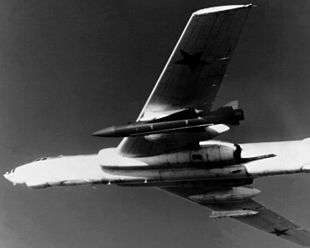
Andrei Tupolev was a leading aircraft designer of Soviet Russia. Tupolev was part of a company that specialized in all metal military aircraft. Tupolev recruited and formed TsAGI which was the Soviet aviation research institute. From the 1920s until 1937, Tupolev and his group worked on design and production of Soviet aircraft. In 1937, Tupolev was arrested by Stalin during the Great Purge. While in prison at Bulshevo Prison in Moscow, Tupolev was recruited by the NKVD to run TsKB-29. This organization utilized political prisoners to produce aircraft for the Soviet state. While in prison, Tupolev began to focus on bomber design and produced the Tu-2 which became the premier Soviet bomber during World War II.[25]
After World War II, Tupolev was assigned to working on reverse engineering scavenged US B-29 bombers. From his work, he produced the Tu-4. As the Cold war began to take shape, the emphasis began to turn toward speed of aircraft. By 1950, Tupolev's group produced the USSR's first turboprop, the Tu-95. Production and design progressed rapidly, and by 1952 Tupolev had produced the first Soviet jet bomber, the Tu-16. The Tu-22 quickly followed as a twin engine jet bomber. The Tupolev group evolved more into civilian jet aircraft until his death in 1972.[25]
Pavel Sukhoi
Pavel Sukhoi was a senior designer at the Central Aerohydrodynamics Institute in Moscow. This design group was under the control of Tupolev's TsAGI. In 1939, Moscow ordered Sukhoi to head a new scientific research group called OKB. This organization was based in modern-day Kharkiv, Ukraine. This new organization under Sukhoi's direction began research and design of round attack aircraft. The first of these was these was the Su-6. The onslaught of the Nazi invasion disrupted fighter development for the OKB. Following the end of World War II, Stalin directed Sukhoi to begin investigations into jet aircraft.[26] Early development issues, combined with political prejudice, doomed the first Soviet jet fighter, the Su-9, and it was never in production. Stalin thought the group's designs were too close to captured German jet aircraft. As a result, the design bureau was closed and moved back to Tupolev's department in Moscow.[26]
Sukhoi's luck changed again in 1953 when Stalin died. The new government permitted him to create another independent jet fighter design group. By 1954, the group was named OKB-51, which remains to this day an active research group. The early 1950s and 1960s yielded tremendous results in the form of the Su-7 and delta wing Su-9. These two fighters were individually updated with new technology to later become the Su-11 and Su-15 fighter interceptors. Upon his death in 1975, Pavel Sukhoi's name was added to the bureau name in recognition of his services.[26]
Development of MiG aircraft
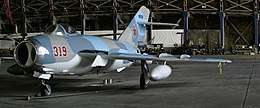
One of the premier fighter jet aircraft that Russia employed throughout the duration of the Cold War was the MiG. In a Britannica Academic article, Siddiqi explains that in 1939, Joseph Stalin called for the creation of a new jet aircraft for the Russian military. The men chosen to lead the design of this new fighter were Artem I. Mikoyan and Mikhail I. Gurevich; the abbreviation MiG is a conjunction of the last names of these men. The first aircraft they designed was the I-200. The I-200 was a single engine jet, designed to operate at high altitudes and at high speed to intercept enemy bombers. This aircraft was first flown in 1940 (only 1 year after Stalin's declaration), and it was later renamed the MiG-1. Later, an improved MiG-3 was developed, and by 1942, Mikoyan and Gurevich's team was made an independent design bureau, known informally as MiG, but formally as OKB-155 (which stands for Experimental Design Bureau in Russian).[27]
Throughout the Cold War, OKB-155 churned out some of Russia's most important jet aircraft. According to Siddiqi, technical information captured from defeated Germany played a substantial role in OKB-155 rolling out the USSR's first jet fighter, the MiG-9, in 1946. Other prominent jets designed and produced by this group include the MiG-15, the MiG-17, the MiG-19, the MiG-21, the MiG-23, and the MiG-25. The MiG-15 through the MiG-21 were produced in the mid-1940s into the latter part of the 1950s. The MiG-23 and MiG-25 were not developed until the 1960s. Each of these aircraft offered unique capabilities to the Soviet military. The MiG-15 was employed primarily against American forces during the Korean War, and proved to be highly successful. The MiG-17, −19, and −21 continued to improve upon this design, as each model reached progressively greater speeds; The MiG-19 was Russia's first supersonic jet to be produced in industrial quantities, and the MiG-21 attained speeds in excess of Mach 2. Finally, the MiG-23 was the Soviet Union's first variable-sweep wing fighter aircraft, and the MiG-25 was Russia's first jet capable of reaching Mach 3.[27]
Space age advances
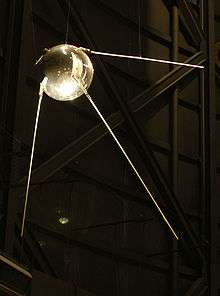
Sputnik 1 was the first artificial Earth satellite ever launched. On October 4, 1957, the USSR launched Sputnik 1 into orbit and received transmissions from it.[28] Sputnik 1 was designed to be the forerunner for multiple satellite missions. The technology constantly underwent upgrades as the weight of satellites increased. The first notable failure occurred during Sputnik 4, an unmanned test of the Vostok capsule. A guidance system malfunction pointed the capsule in the wrong direction for the orbit-exiting engine burn, sending it instead into a higher orbit, which decayed approximately four months later.[29] The success of Sputnik 1 was followed by the launch of 175 meteorological rockets in the next two years. In all, there were ten of the Sputnik satellites launched.
The Soviet Space Program brought about numerous advances such as Sputnik 1[30]. However, before the institution of the satellite probe, technology needed to be developed in order to ensure the success of the satellite. In order for the probe to be successful in space, a mechanism needed to be developed to get the object outside Earth's atmosphere. The propulsion system that was utilized to send Sputnik 1 into space was dubbed the R-7. The design of the R-7 was also unique for its time and allowed for the Sputnik 1 launch to be a success. One key aspect was the type of fuel utilized to propel the rocket. A main component of the fuel was UDMH[31] which when combined with other compounds yielded a fuel that was both potent and stable at certain temperatures.
The ability to launch satellites came from the Soviet intercontinental ballistic missile (ICBM) arsenal, using the RD-107 engine for the Vostok launch vehicle. The first Vostok version had 1 core engine and 4 strap-on stage engines. The engines were all vectored thrust capable. The original Vostok was fueled by liquid oxygen and kerosene. There were a total of 20 engines, each capable of contributing 55,000 pounds-force (240 kN) of thrust.[32] The Vostok engine was the first true Soviet design. The technical name was the RD-107 and later the RD-108. These engines had two thrust chambers. They were originally mono-propellant-burning using hydrogen peroxide fuel. This family of engines were utilized not just on the Vostok, but also on the Voskhod, Molniya, and Soyuz launch vehicles.[7]
By 1959, the space program needed a 3-stage engine platform, so the Vostok engine was adapted accordingly for launching Moon probes. By 1963, the Vostok was equipped for 4-stage applications. This platform was used for the first multi-manned flight.[33] As 1964 began, the Soviets introduced a new engine into its booster engine program, the RD-0110. This engine replaced the RD-107 in the second stage, in both the Molniya and Soyuz launch vehicles. These engines were liquid oxygen propelled, with kerosene coolant. The RD-0110 had four variable thrusters. This engine was unique because it initially was launched by a solid fuel propellant, but was fueled in flight by liquid oxygen.[7]
This development caused a new problem for the Soviet scientific community, however. The Vostok was too powerful for newer satellites trying to reach low Earth orbit. The space community turned once again to the Soviet missile command. The new Intermediate Ballistic Missiles (IBRM) systems provided two engine options: the Sandal (1 stage), or the Skean (2 stage). Both systems were upgraded to a new RD-111 engine. Following these upgrades, the largest satellite called Proton I was launched in 1965.[34] The type of engine used for Proton I was the RD-119. This engine provided nearly 13.3 million newtons (3.0 million pounds-force) of thrust, and was ultimately used to execute low Earth orbit.[34]
December 8th, 1957 the Soviet Union head of the Academy of Science addressed the United States in regard to the first artificial satellite that was sent off on October 4th, 1957. It was his belief that part of this satellite had fallen back into the North American Continent. The Soviets were wanting the help of the Americans in order to recover the satellite components, however the United States was planning on viewing the satellite technology in order to develop their own satellites and rockets for propulsion and re-entry.[35]
From the year 1961-1963 the Soviet Union wanted to improve on their designs. This led to the development of a new rocket for propulsion. This new rocket was dubbed the N-1. This rocket was to become a sophisticated improvement on traditional Soviet design and would pave the way for numerous rocket launches. The specifications to the rocket were also astounding for its time. The amount of thrust generated by the rocket ranged from 10-20 tons of thrust which was capable of launching a 40-50 ton satellite into orbit. [36] The man that played a crucial role in the development of this new rocket was Sergei Korolev. He oversaw the development of the rocket and ensured that it became a success.The development of the N-1 rocket became the successor to other Soviet designed rockets such as the R-7. It also brought about ample competition to the United States' counterpart rocket Saturn V. However, one key difference between the two rockets was the stages that occurred in a typical launch. Whereas Saturn V had four-stages, the N-1 had five stages. The fifth stage of the N-1 was utilized for the landing position. The N-1 was powered by powerful engines such as the NK-33, NK-43, and NK-39. As revolutionary as this design style had become, the construction was not run as smoothly as expected. The clashing of ideas between scientists wanting to go public with their work and military entities wanting to keep the project as secretive as possible caused delays and hindered the project from progressing at times. [37] As time progressed the N-1 was prone to several design flaws. These flaws caused numerous failed launches because of the first stage in its design being faulty. The late 1960s yielded many failed launch attempts. Eventually the program was shut down. [38]
See also
- Soviet space program
- Sergei Korolev (1907-1966), chief engineer and brain of the Soviet rocketry and space program, head of Experimental Design Bureau OKB-1
- Valentin Glushko (1908-1989), chief designer of rocket engines, head of OKB-456
- Dmitry Ustinov (1908-1984), military head of Soviet rocketry and space program, People's Commissar of Armaments from 1941, Defence Minister from 1976
- Boris Chertok (1912-2011), control systems designer
References
- Siddiqi, Asif (July 2003). "The Rockets' Red Glare: Technology, Conflict, and Terror in the Soviet Union". Technology and Culture. 44 (3): 470–501. doi:10.1353/tech.2003.0133. JSTOR 25148158.
- van Pelt, p. 120
- Stoiko, p. 46
- Stoiko, pp. 43–44
- Stoiko, p. 51
- Stoiko, pp. 51–53
- Sutton, George (Nov–Dec 2003). "History of Liquid-Propellant Rocket Engines in Russia, Formerly the Soviet Union". Journal of Propulsion and Power. 19 (6): 978–1007. doi:10.2514/2.6943.
- West, John (2001). "Historical Aspects of the Early Soviet Russian Manned Space Program". Journal of Applied Physiology. 91 (4): 1501–1511. doi:10.1152/jappl.2001.91.4.1501. PMID 11568130.
- van Pelt, p. 121
- van Pelt, pp. 121–122
- van Pelt, p. 122
- van Pelt, p. 123
- van Pelt, pp. 123–125
- "Helmut Gröttrup". Encyclopedia Astronautica. Retrieved 2019-09-03.
- Stoiko, p. 71
- Hall, Peter. "Deutsche Mitarbeiter am Institut Nordhausen" [German employees at the Institut Nordhausen)]. Peter Hall (in German). Retrieved 2019-09-02.
- Stoiko, pp. 71–72
- Zak, Anatoly. "Operation "Osoaviakhim"". RussianSpaceWeb. Retrieved 2019-09-02.
- Siddiqi, Asif (December 2004). "Russians in Germany: Founding the Post-War Missile Programme". Europe-Asia Studies. 56 (8): 1131–1156. doi:10.1080/1465342042000308893. JSTOR 4147400.
- "G-4". Encyclopedia Astronautica. Retrieved 2019-09-02.
- Cutter, Paul (2009-09-29). "Helmut Groettrup … the captured Russian who was Russian POW rocket scientist" (PDF; 386 kB). Paul S. Cutter. Retrieved 2019-05-19.
- Maddrell, Paul (February 2006). Spying on Science: Western Intelligence in Divided Germany 1945–1961. Oxford University Press. ISBN 978-0-199-26750-7.
- "R-11". Encyclopedia Astronautica. Retrieved 2019-09-02.
- Chertok, B. (2004). "German Influence in USSR". Acta Astronautica. 55 (3–9). Bibcode:2004AcAau..55..735C. doi:10.1016/j.actaastro.2004.05.025.
- Siddiqi, Asif. "Tupolev". Britannica Academic. Encyclopædia Britannica. Retrieved April 4, 2016.
- Siddiqi, Asif. "Sukhoy". Britannica Academic. Encyclopædia Britannica. Retrieved April 4, 2016.
- Siddiqi, Asif. "MiG". Britannica Academic. Encyclopædia Britannica. Retrieved April 4, 2016.
- Stoiko, p. 79
- Stoiko, pp. 84–87
- Harvey, Brian. "Soviet and Russian Lunar Exploration". Springer Links Books
- Harvey, Brian (2007). Soviet and Russian Lunar Exploration. Dublin: Praxis Publishing. pp. 38–40. Bibcode:2007srle.book.....H. ISBN 978-0-387-21896-0.
- Stoiko, p. 93
- Stoiko, p. 95
- Stoiko, p. 97
- Odishaw, Hugh (December 1957). "Soviet Satellite Carrier Rocket". Science. 126 (3287): 1334–7. Bibcode:1957Sci...126.1334O. doi:10.1126/science.126.3287.1334. JSTOR 1752752. PMID 17820092.
- Chertok, Borris (1997). Rockets and People. Washington DC: NASA. p. 64.
- Oreskes, Naomi (2014). Technology in the Global Cold War. Cambridge, MA: MIT Press. pp. 189–193.
- Huntress, Wesley; Marov, Mikhail (2011). Soviet Robots in The Solar System: Mission Technologies and Discoveries. Chichester, UK: Praxis Publishing. pp. 63–65. ISBN 978-1-4419-7897-4.
Cited sources
- Stoiko, Michael (1970). Soviet rocketry: past, present, and future. Holt, Rinehart and Winston.
- van Pelt, Michel (2012). Rocketing Into the Future: The History and Technology of Rocket Planes. Springer Science & Business Media. ISBN 978-1-4614-3200-5.
Bibliography
- Burgess, Colin, and Hall, Rex. The First Soviet Cosmonaut Team: Their Lives, Legacy, and Historical Impact. Berlin: Springer, 2009.
- Chertok, B. (2004). "German Influence in USSR". Acta Astronautica. 55 (3–9): 735–740. Bibcode:2004AcAau..55..735C. doi:10.1016/j.actaastro.2004.05.025.
- Chertok, B. E. Rockets and People: Volume II. Washington, D.C.: NASA, 2006. Accessed April 7, 2016.
- Chertok, Boris Evseyevich. Rockets and People: Volume IV: The Moon Race. Washington, D.C.: National Aeronautics and Space Administration, NASA History Office, Office of External Affairs, 2005.
- Columbia Electronic Encyclopedia, 6th Edition. Wernher Von Braun. June 2015. Accessed April 8, 2016.
- Darrin, Ann Garrison and O'Leary, Beth Laura. Handbook of Space Engineering, Archaeology, and Heritage. Boca Raton: Taylor & Francis, 2009.
- Faure, Gunter, and Mensing, Teresa M. Introduction to Planetary Science: The Geological Perspective. Dordrecht: Springer, 2007.
- "Glushko." Encyclopedia Astronautica Glushko. Web, Accessed 08 Apr. 2016.
- Hagler, Gina. Modeling Ships and Space Craft: The Science and Art of Mastering the Oceans and Sky. New York: Springer, 2013.
- Harvey, Brian. Russian Planetary Exploration: History, Development, Legacy, Prospects. Berlin: Springer, 2007.
- "Konstantin Tsiolkovsky". Florida International University. Accessed 08 Apr. 2016.
- "Konstantin Tsiolkovsky." NASA. Accessed 08 Apr. 2016. <https://www.nasa.gov/audience/foreducators/rocketry/home/konstantin- tsiolkovsky.html>
- Lethbridge, Cliff. "History of Rocketry Chapter 6: 1945 to the Creation of NASA." Spaceline. (2000). Accessed April 7, 2016. http://www.spaceline.org/history/6.html.
- MSFC History Office: NASA. Biography of Wernher Von Braun. Accessed April 7, 2016.
- O'Brien, Jason L.; Sears, Christine E. "Victor or Villain? Wernher von Braun and the Space Race". Social Studies. 102 (2).
- "Sergei Korolev." Russian Space Web. Web, Accessed 08 Apr. 2016.
- "Yury Alekseyevich Gagarin." Encyclopædia Britannica.